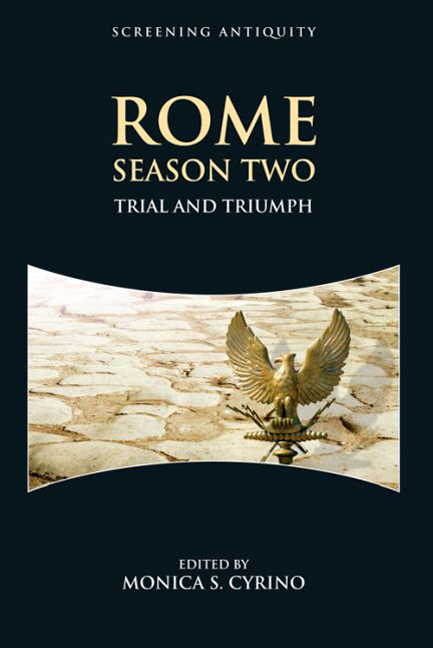Book contents
- Frontmatter
- Contents
- Series Editors’ Preface
- Editor's Acknowledgments
- Contributors
- List of Illustrations
- Episode Listing
- Cast List
- Introduction: The Trials and Triumphs of Rome, Season Two
- PART I POWER AND POLITICS
- 1 A Touch Too Cerebral: Eulogizing Caesar in Rome
- 2 Discharging Pullo and Vorenus: Veterans in Rome
- 3 Gangsterism in Rome
- 4 Class, Chaos, and Control in Rome
- 5 Earning Immortality: Cicero's Death Scene in Rome
- 6 The Triumvirate of the Ring in Rome
- 7 Jews and Judaism in Rome
- PART II Sex and Status
- Filmography
- Bibliography
- Index
2 - Discharging Pullo and Vorenus: Veterans in Rome
from PART I - POWER AND POLITICS
Published online by Cambridge University Press: 07 October 2017
- Frontmatter
- Contents
- Series Editors’ Preface
- Editor's Acknowledgments
- Contributors
- List of Illustrations
- Episode Listing
- Cast List
- Introduction: The Trials and Triumphs of Rome, Season Two
- PART I POWER AND POLITICS
- 1 A Touch Too Cerebral: Eulogizing Caesar in Rome
- 2 Discharging Pullo and Vorenus: Veterans in Rome
- 3 Gangsterism in Rome
- 4 Class, Chaos, and Control in Rome
- 5 Earning Immortality: Cicero's Death Scene in Rome
- 6 The Triumvirate of the Ring in Rome
- 7 Jews and Judaism in Rome
- PART II Sex and Status
- Filmography
- Bibliography
- Index
Summary
Readers’ interest in the Roman army and battles often does not extend to considering veterans, yet they were a significant part of Roman military life. Every man not killed during service became a veteran. Since two of the primary characters in the series Rome start out as soldiers, and the military is present in every episode, it should not be surprising that veterans figure prominently. As with its treatment of active military life, the treatment of veterans in Rome is similarly successful. Once we disregard those production choices made for the dramatic and narrative requirements of a historical television series, what emerges is a useful treatment of some issues veterans faced in ancient Rome. Examining two specific aspects of veterans’ experience in the series and in the historical record – their reintegration into society and relationships with political leaders of the period – highlights some ways in which the treatment of veterans in Rome is useful for an audience seeking to understand veterans better, whether Roman or other.
ROMAN VETERANS IN FILM
Whereas one can write about a tradition of the Roman army in film, there is much less to be reported about Roman veterans on film. In the last forty years there are only four feature films in which Roman veterans appear: Gladiator (2000), King Arthur (2004), The Last Legion (2007), and The Eagle (2011). Admittedly, the protagonist in Gladiator was not a veteran for long on screen, but even so brief a veteran status justifies inclusion. It is no coincidence that in all four films the veterans play similar roles – after being abused, abandoned, or forgotten (or some combination) by flawed leaders and/or policies, the veterans are eventually provoked into picking up weapons and armor to restore freedom and order, if not also Rome itself. The success of Gladiator spawned many imitators, and the plot of a redeemed hero restoring order and getting revenge is a standard one. While it may be surprising that Roman veterans do not appear more often in feature films, it is more astonishing that this “revenge plot” has been the only one for Roman veterans in film, especially given that the military veteran has been a staple character in film history.
- Type
- Chapter
- Information
- Rome Season TwoTrial and Triumph, pp. 25 - 35Publisher: Edinburgh University PressPrint publication year: 2015



